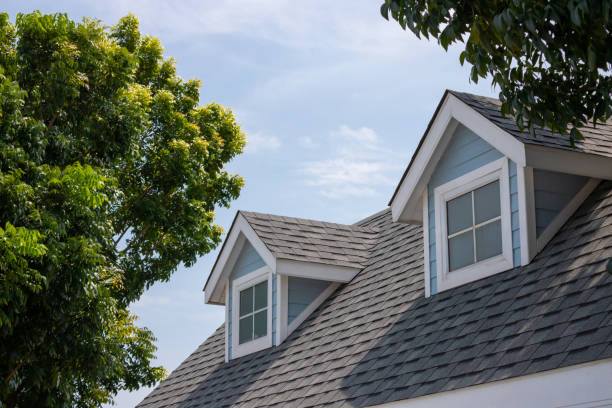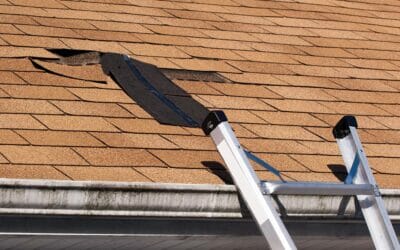
This article serves as the main site of our ‘Residential/ Steep Slope Materials’ series. Here we will cover an overview of the main roofing materials available for sloped roof applications, and then a series of deep-dive links at the bottom into our Learning Center to explore more about the pros and cons of numerous different roofing options available to consumers today. Our team installs a variety of roofing materials, so our primary interest is merely in helping customers learn more and explore what options might be the best fit for them.
There are many different materials to choose from when it’s time to replace your home’s roof. You can select from man-made materials, such as asphalt, or natural alternatives like wood or clay, though you’re certainly not limited to just those examples. Roofing materials vary in aesthetics, price, and longevity. Kansas experiences 4 distinct seasons and many different weather conditions. Humidity, heat, heavy rains, some snow, sleet, and hail are all weather factors that come up in South-central Kansas, and are important factors to consider when deciding on a roofing material. Another factor that goes into selecting a roofing material is popularity and regional style, which varies throughout the region based on local architectural style and climate.
This article is primarily focused on common roofing styles and materials found in Wichita, Kansas and applicable to the lower Midwest. For a more detailed breakdown of pricing by material, see our roof costs series. We understand that making construction and style decisions about their roof can be challenging for many homeowners. Our team of experts here at Rhoden Roofing are happy to help reduce the stress that can come with roof replacements.
Wichita has a variety of home types, but prominently features Craftsman and ranch-style homes, with a mix of Colonial, Tudor, Spanish/American Southwest architecture, and an occasional modern home. Let’s discuss the benefits and drawbacks of the four most popular residential roofing materials in the region.
Asphalt Shingles
Also called “composite” or “composition” shingles, this material has withstood the test of time and is still the most popular roofing material today. Nationally, asphalt shingles are used in nearly 80% of single-family homes in the US, and in Wichita can be found on roughly 85% of the single-family homes. Composite asphalt shingles are the most common roof type for American Craftsman, Colonial architecture, and ranch-style houses that are common in Wichita.
As the most common roofing material, asphalt shingles have the most variety in cost, quality, color, and style; manufactured by over a dozen major companies in the US. Relative to other roofing materials, asphalt shingles are the most affordable thanks to efficient manufacturing and ease of installation. Asphalt shingles layer a base mat, usually fiberglass, coated with asphalt and surfaced with mineral granules. The wide variety of asphalt shingle options manufactured range from budget “3-tab” shingle varieties, to “architectural” (also known as ‘laminated’ or ‘dimensional’ shingles). Different patterns and aesthetic options give homeowners a range of looks to explore (Style: Asphalt Shingle Roof Types). High-end products can also carry a Class 4 impact-resistant rating (What is a Class 4 Rating & Who Makes That Determination?)
Asphalt shingles are highly resistant to water, wind and fire, as well as easily repaired and replaced if damaged. Asphalt shingles do not require specialized installation, so finding a qualified contractor is easier when making repairs and replacing an asphalt shingle roof. Building code varies by region to adjust for climate differences, but asphalt shingles can be appropriately installed on a wide variety of roof slopes/pitches, ranging from 2/12 in Kansas (with additional ice & water barrier installed underneath) all the way to vertical mansards.
As a general rule, many asphalt shingle products are expected to last about 20 years, barring major storm events causing direct damage. However, some shingle manufacturers offer product lines that carry up to a 50-year product warranty, which competes with premium roofing material options.
Flat Roofs
Roofing materials are generally divided within the industry into “low-slope” (flat) and “steep-slope” (anything that isn’t flat). However, many people think of flat roofing to be a commercial product, and low-slope roofing is often simply categorized as “commercial” even though many residential homes have flat roofs or sections of flat roofing. In fact, we’re guilty of the same thing – take a look at our Low Slope & Commercial Materials Series to learn more about flat roofing products and options. Flat roofs are made with fully water-sealed membranes, of which there are many different materials.
Flat roofs can wonderfully complement modern houses. Modern, and Mid-Century Modern houses from the 1950s and 60s are famous for incorporating flat roofs. However, flat roofs are also found incorporated into hacienda architecture, terrace roofs, and certain New England style houses with features such as “widow’s walks.” Even if an entire roof is not flat, often, a section of a house may have a flat roof over an addition or covered porch, and require a mix of flat roofing materials and “steep-slope” traditional roofing materials like shingles.
Flat roofs allow easy accessibility for roofing contractors, meaning that getting the job done is quick and cost-effective. Inspections and repairs can be carried out quickly, as well. Flat roofs offer a sleek look to your home, and they are easy low-maintenance roofing options.
Metal Roofing
Though asphalt shingles remain the most popular choice, metal roofing is gaining popularity. While this material will cost you more upfront, metal roofing systems have superior longevity, storm resistance, wind and fire ratings, and are more eco-friendly. They can also reduce your energy costs thanks to their reflective abilities and providing a radiant barrier into your home. You can find metal roofing options in a variety of materials, including copper, steel, and aluminum. Metal roofing systems have a long lifespan, averaging around 70 years.
For some, the decision to go with a metal roof is purely aesthetic; you simply cannot imitate the look of copper or distinctive metallic shine of a color-coated metal roof. Metal roofs come in several varieties, including standing seam, R-panel, and corrugated metal. Metal roofs are lightweight, meaning less strain on a home’s structure, especially as compared with heavy tile options which may sag or sway a roofline over several decades.
Metal roofs are often considered when compared directly to traditional asphalt shingle roofs, so here is a much more detailed breakdown of the many considerations between Asphalt Shingles vs Metal Roofing, including treatment by insurance carriers, installation considerations when switching types, construction and decking requirements, etc.
Tile Roofing
When it comes to longevity, clay tiles top the list. With proper care and maintenance, clay tiles can last up to 100 years on your home’s roof. They are also fireproof and highly resistant to damage from wind, extreme heat, rain, and hail. The way in which clay tiles are laid on your roof creates an air pocket that forms an additional layer of insulation, too. Concrete tiles are another attractive option, though they aren’t quite as durable as clay. You can expect about 50 years out of concrete tiles, which for many, is still more than enough. Slate roofs are also often grouped in with other tile options – a natural material with 100+ year durability, but in many cases coming in at a price point even higher than clay and requiring specialized craftsmanship for installation. Not all homes are structurally fit for heavier tile roofs, so additional engineering and reinforcements may be needed if switching roof types to tile.
Spanish and American Southwest architecture is famous for the look of red clay tile roofs. For some, the look and finish of a tile roof are unmatched. Even in the lower Midwest, clay tile is still common, although here in Kansas there are as many concrete tile or slate roofs as clay tile given the wider variety of architectural styles found here.
Composite/ Synthetic
Composite roofing materials are a balance of cost, style, and longevity. Manufactured in many design styles, these can match the look of cedar shake shingles, slate tile, or designer shingles, just to name a few, while offering increased longevity and storm resistance. A leading manufacturer of composite/synthetic roofing materials is DaVinci, which has lead to many using the brand name in place of the product category as a whole (a bit like Kleenex vs facial tissues), although there are other manufacturers as well.
Composite roofing materials have grown steadily in popularity over the last two decades thanks to technological advances and increased design options to match many home and architectural styles.
Learn About Roofing Materials in Greater Detail
This article is part of our ‘Residential/ Steep Slope Materials’ Series. Learn more about:
- Asphalt Composite Shingles
- Metal Roofing
- Wood/ Cedar Roofing
- Other
- Roof Component Materials
- Traditional “Organic” Felt vs Synthetic Underlayment: Which is better?
- What Is the Difference Between Open and Closed Valley Installation?
- Continuous Venting Ridge vs Static/Box Vents: Which is better?
- What Are the Benefits to a High Profile Hip and Ridge Shingle?
- What Is a Class 4 Rating? Who Makes That Determination?
If you are a homeowner considering a roof replacement, the experienced team at Rhoden Roofing is here to help. Give Wichita’s most-trusted roofing contractor a call today and we offer free estimates for all your roofing needs.



